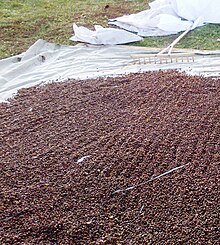Pine nut


The pine nut , the Pignole or Austrian Pignolie called, is the shelled seeds, the core of the Mediterranean growing pine . But the term “pine nut” actually applies to all edible kernels from different types of pine worldwide. The whitish, edible core grows in the pine cones. In terms of taste, it is slightly reminiscent of fir resin.
Use and growing areas
Pine nuts are very popular in Mediterranean cuisine - for baking, in salads or for direct consumption. In the Turkish and Arabic cuisine they are often found in rice dishes. Pine nuts are a component of pesto alla genovese from Italian cuisine and the “Torta della Nonna” (grandmother's cake).
Peeled pine nuts go rancid very quickly because their fat content is very high:
- Fat : 60%
- Protein : 14%
- Carbohydrates : 13%
Their physiological calorific value is 2485 kJ (602 kcal) per 100 g . Pine nut oil has a very high content of oleic acid (39.1%) and linoleic acid (46.5%).
Since the kernels of the European pine (the Mediterranean pine ) are very expensive; They come from Spain, France, Portugal and Turkey , and recently they have often been imported from the People's Republic of China , Afghanistan or Korea , seeds, kernels z. B. from the Korean pine or from Pinus gerardiana , and less from Russia from Pinus sibirica , Pinus pumila u. a. to Europe. These Asian pine seeds (cedar nuts) can be easily recognized by their triangular shape and dark tip. Compared to the southern European kernels, they taste less resinous and aromatic and are even more fatty. In the USA and Mexico , pine nuts are predominantly obtained from Pinus edulis , Pinus cembroides or Pinus monophylla .
Comparable in taste, but not used commercially, are the edible pine nuts of the Alpine stone pine or the araucarias, which are only used regionally, e.g. B. from the Chilean araucaria .
Extraction
Pine nuts are mainly harvested from wild-growing pine trees, as there are only sporadic pine trees. The pine trees only have cones after about 20 years . The pine cones are harvested manually between October and April. The pickers, so-called “pineros”, have to climb the pine trees to harvest. There they knock down the tenons one by one with sticks. In Mongolia , the pines are shaken with battering rams to pick up the cones on the ground. This contributes to the decline in the pine population. The harvested pine cones are dried the following summer. Drying causes the brown seeds to fall out of the cones. The seeds are first soaked in water and then mechanically removed from the hard seed coat and the seed membrane .
Risks
In isolated cases, serious, temporary taste disturbances have been reported after consuming kernels from China and Pakistan . These develop about 1–3 days after consumption and last for days to weeks. A bitter, metallic taste is described, but this does not appear to be dangerous. Despite the first description in 2001 in Belgium and numerous cases worldwide, research in this area is not very advanced.
See also
Web links
Individual evidence
- ↑ Waldemar Ternes , Alfred Täufel, Lieselotte Tunger, Martin Zobel (eds.): Food Lexicon . 4th, comprehensively revised edition. Behr, Hamburg 2005, ISBN 3-89947-165-2 .
- ↑ pine nuts. In: www.fruitlife.de. Retrieved January 29, 2020 .
- ↑ Nane Gisela Busse: Why are pine nuts so expensive? - Here's the explanation. In: www.helpster.de. Retrieved January 29, 2020 .
- ↑ Mongolian pine nuts including dead forests. In: Mongoleireise.com. December 21, 2017, accessed January 29, 2020 .
- ↑ Mostin M .: key disturbances after pine nut ingestion . In: Belgian Poison Center (ed.): Eur J Emerg Med. . 8, No. 1, March 2001, p. 76. doi : 10.1097 / 00063110-200103000-00036 . Retrieved July 20, 2009.
- ↑ Federal Institute for Risk Assessment, Information No. 045/2011 (PDF; 33 kB) Retrieved on December 31, 2012.


